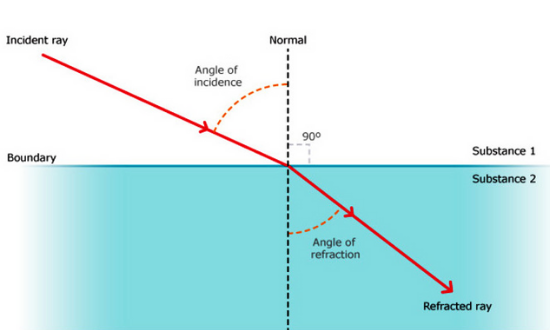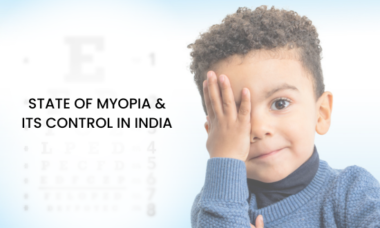- Refraction of light
- Refractive errors
- What is Myopia?
- Myopia Symptoms
- Types of Myopia
- Myopia Correction/Treatment
In the present time where more than 25% of the world’s population requires eye correction to gain perfect vision, it becomes important to acquire knowledge of the different eye conditions so you can be aware of the solutions to seek.
One of the commonly found conditions I will be discussing in this blog is Myopia. But to commiserate thoroughly we need to clear some basics.
To begin with, let us understand the basics of refractive errors.
What is the Refraction of light?
The light coming from the origin when travels from one medium to another medium it is called refraction of light. The light ray bends towards 90 degrees when it travels into another medium.

On the basis of this physics of light, convex and concave lenses were developed for the purpose of refractive correction.
The next terminology to understand is Focal length.
Light rays upon passing through a convex lens converge and meet at a point called focal point and the distance from the lens and the focal point is called the focal length.
This phenomenon works for your eyes as well. The crystalline lens of the eye is biconvex by nature. The rays enter your eyes through the cornea, pupillary gap, and then the lens converges such that the focal point falls upon the retina.
An inverted image is formed on the retina which is transmitted to the brain by the photoreceptors via the optic nerve. This is the basic mechanism of vision.
Now, that the basic terminologies are clear, we move to
Refractive errors
Comprehensively, there are three types of refractive errors:
- Emmetropia
- Ametropia
- Antimetropia
In short brief, Emmetropia refers to a healthy eye wherein parallel light rays coming from a distance of 20 ft. travel through the cornea and lens when the accommodation of lens is zero and forms the focal point on the retina. A perfect 6/6 vision is achieved.
Ametropia is an eye condition wherein parallel light rays do not focus on the retina when the accommodation of the lens is zero. Ametropia is further classified into various types one of which is Myopia.
It is estimated that by 2050 more than 50% of the world population will be Myopic.
So, what is Myopia?
In a myopic eye, the light rays traveling through the lens bend more towards 90 degrees and converge such that the focal point falls before or in front of the retina. This results in blurred vision.

Naturally, the power of the crystalline lens is +14.0 to +18.0 Dsph. In a myopic condition, the power of the lens is higher than normal. Hence, making the light rays bend more preventing the focal point from reaching the retina.
Myopia is also known as near-sightedness. It is because myopic patients lose the ability to see things clearly at distance but the near vision is clear.
Symptoms of Myopia
- Distance vision is blurred but near is clear
- Black Floaters could be seen.
- Myopic patients feel eye strain especially if less power correction is needed.
- In children, parents notice twitching eyebrows or frowning. Often teachers advise parents to get an eye checkup in a case when a child is unable to copy from the board.
- Inability to read signboards.
- Squinting of eyes.
- Headaches in some cases.
Myopic increases with age hence these symptoms must be addressed immediately. It also increases the risk of ocular complications such as:
- Retinoschisis
- Posterior staphyloma
- Lattice degeneration
- Posterior vitreous detachment
Myopia can be controlled under the supervision of an eye doctor, optometrist, and optician. But before looking into it let us see how different types of myopic conditions occur.
Types of Myopia
- Axial Myopia: Also known as Malignant Myopia occurs when the length of the eyeball is more than normal causing the light rays to focus in front of the retina. People with this type of myopic condition are at high risk of cataracts or retinal detachment witnessing symptoms like bleeding in the eye or surge in the growth of blood vessels. It is a rare and mostly hereditary condition starting to develop from childhood. It is crucial to refer an eye doctor in such a case. Another condition is High myopia, where the eyeball grows longer than its average length and hence making vision blurred at distance. There are chances of a detached retina, cataract, and glaucoma in this condition.
- Curvatural Myopia: It occurs when the curvature of the cornea or lens is more than normal. Normally, the curvature of the cornea and the lens is 8mm.
- Index Myopia: If the index of the lens increases, light rays bend more and focus in front of the retina. The normal refractive index of the lens is 1.39.
- Positional Myopia: The lens is positioned between the anterior and the posterior part of the eye. But, if due to any reason such as an accident, it moves to the interior of the eye then the focal point forms in front of the retina.
Treatment of Myopia / Myopia Correction
Having known the severity of the condition the obvious question that arises in mind is about the treatment.
Myopia is usually treated with
- Myopia glasses / Nearsighted glasses
- Contact lens for Myopia / Short-sighted lens
- Eye surgery for Myopia (Photorefractive keratectomy & Nearsighted LASIK)
Depending on the degree of convergence, myopic patients need to wear either eyeglasses or contact lenses to gain accurate vision.
With the definite rise in the number of myopic cases, there are a lot of methods such as bifocals for myopia, progressive lenses, contact lenses for myopia, along with a low dosage of atropine drops have been practiced on children to control myopia at an early age to prevent further loss of vision. However, all these methods have shown mixed results.
For adults wearing eyeglasses for myopia correction with Anti-reflective coating is much recommended. This type of coating increases the light transmission through the lenses allowing the person wearing them to gain nearer to 100% vision.
The success ratio of contact lenses in controlling myopia is 47% to 50%. Modern-day silicone lenses offer higher transmission of oxygen giving superior comfort and cure.
The Photorefractive keratectomy, also known as PRK uses laser technology to sculpt the middle layer of the cornea. This straightens the curve of the cornea and helps light rays to concentrate near to or on your retina.
In Lasik, to build a thin flap on the top layer of the cornea, the surgeon uses a laser or another instrument. Using a separate laser, they sculpt the cornea and move the flap back into place.
If you are experiencing any of the above-mentioned symptoms, especially difficulty in seeing distant objects, book your appointment with an eye doctor, optometrist or your local optician without any further delay.





